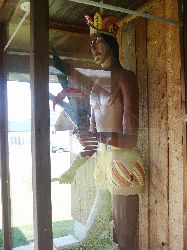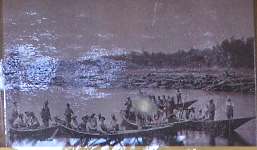 (1930's plat shown on the left courtesy of Cornell Historical Society) "Little Falls" a name given to compliment "Big Falls" (Chippewa Falls) stayed with this logging community until it gained a post office in 1898. It's first Postmaster, Amasa J. (1930's plat shown on the left courtesy of Cornell Historical Society) "Little Falls" a name given to compliment "Big Falls" (Chippewa Falls) stayed with this logging community until it gained a post office in 1898. It's first Postmaster, Amasa J. Edminster named it "Martin". This name would be short lived as the Omaha Railroad was soon to change the name of both to Holcombe". The name of "Little Falls" was as hard to kill as Adolph Bernier, a local businessman laid out the first plat of "Little Falls" in 1902. The Omaha
Railroad was coming up from the south that year and the company wanted to locate a depot nearby, but Bernier and the railroad could not agree on terms for the land purchase. As a result, the railroad bought land to the south of the dam and called it "Holcombe" and "Little Falls" got it's new name and post office on December 6, 1902. The community which was called "Little Falls" north and east of the dam was called Barney Town" after Bernier. Holcombe, named after an employee of the Omaha Edminster named it "Martin". This name would be short lived as the Omaha Railroad was soon to change the name of both to Holcombe". The name of "Little Falls" was as hard to kill as Adolph Bernier, a local businessman laid out the first plat of "Little Falls" in 1902. The Omaha
Railroad was coming up from the south that year and the company wanted to locate a depot nearby, but Bernier and the railroad could not agree on terms for the land purchase. As a result, the railroad bought land to the south of the dam and called it "Holcombe" and "Little Falls" got it's new name and post office on December 6, 1902. The community which was called "Little Falls" north and east of the dam was called Barney Town" after Bernier. Holcombe, named after an employee of the Omaha  Railroad possibly the surveyor or the person who platted the town and right of way was located south and east of the dam where it stands. After the dam was abandoned most of the houses in "Barney Town" were either moved, torn down, or burned down and the
village of Holcombe developed to the south of the dam. Railroad possibly the surveyor or the person who platted the town and right of way was located south and east of the dam where it stands. After the dam was abandoned most of the houses in "Barney Town" were either moved, torn down, or burned down and the
village of Holcombe developed to the south of the dam. |
|
Puffer -Hubbard Mill was located east along the track opposite Quarrels and Spooner Ave. The Depot was next to the tracks on the north side of Irvine Ave. As soon as the new railroad was assured, A. J. Edminster moved his small store and post office from his farmhouse at Martin Settlement three miles south of Holcombe into a new building on the corner of Main and Spooner Ave. He build a warehouse and planing mill along the tracks and began maneuvering to get the depot in his part of Holcombe.
|
H.L. Tinker came to Chippewa county in
April 1906. He was an agent for the Chicago, St Paul, Minneapolis and
Omaha Railway at Holcombe. Born in  Westfield Massachusetts in 1985 he
prospered in Holcombe. Fraternally he was a Mason, an Odd Fellows, and a
member of the Order of Railway Telegraphers. Westfield Massachusetts in 1985 he
prospered in Holcombe. Fraternally he was a Mason, an Odd Fellows, and a
member of the Order of Railway Telegraphers.
Mail deliveries began with the arrival of the Omaha Railroad. In 1903 Edminster was appointed postmaster and the post office was located in a corner of his new store. It was moved in 1919 to an addition to the bank building. Robert Zimmerman succeeded Edminster in 1924 and served as postmaster until Louis G Bernier was appointed in 1933. |
 |
|
In 1945 Percey Tonnacour bought the
old train depot and made it into a bar with
a dance hall in the back. There was also a restaurant
in the back. It was a thriving while the new dam was being built. Living
quarters were upstairs. The bar was sold in 1954. The area around Holcombe held the
greatest stand of white pine in the world and was gone forever in a
matter of a few decades. The mighty Chippewa River made the cutting and
transporting of this great white pinery possible. All that B&W Pictures and narrative on this page unless noted are from the "Holcombe Centennial 1905 - 2005" unless otherwise noted. |
|
 The Chippewa Log and Boom had part of their operation at
"little Falls" which utilized the river to transport the logs to The Chippewa Log and Boom had part of their operation at
"little Falls" which utilized the river to transport the logs to Chippewa before the dams were built in Cornell and Jim Falls. A "Straw
Boss" by the name of Luke Lyons, decided that he needed to create a symbol of
security in the form of a wooden Indian for the men that risked their lives on
the river. The men known as "log rollers" held their respected
position in the logging crew by breaking up the logs when the logs would get interlocked creating a
"Log Jam". The Indian sat above the dam in the mid 1800's until a
flood swept it into the river in 1881. It was found down stream and brought back
to Little Falls and repositioned on the bridge to carry out it's duties. The Indian, carved
from one log, shows the size of the virgin trees that were harvested in the
area. It would have came from a log about 5-6 feet in diameter.
Chippewa before the dams were built in Cornell and Jim Falls. A "Straw
Boss" by the name of Luke Lyons, decided that he needed to create a symbol of
security in the form of a wooden Indian for the men that risked their lives on
the river. The men known as "log rollers" held their respected
position in the logging crew by breaking up the logs when the logs would get interlocked creating a
"Log Jam". The Indian sat above the dam in the mid 1800's until a
flood swept it into the river in 1881. It was found down stream and brought back
to Little Falls and repositioned on the bridge to carry out it's duties. The Indian, carved
from one log, shows the size of the virgin trees that were harvested in the
area. It would have came from a log about 5-6 feet in diameter.The wooden dam would close it's gates while it accepted logs from the local short line for the Chippewa Log and Boom Company. When there were enough logs in the river, the dam would open and the rush of water would carry the logs down the liquid trek to a waiting lumber mill. |
 A logger named Luke Lyons
"borrowed" a log and carved a nine foot Indian out of it. When the owner of
the logs found out he kept one dollar out of his wages to cover his loss. A logger named Luke Lyons
"borrowed" a log and carved a nine foot Indian out of it. When the owner of
the logs found out he kept one dollar out of his wages to cover his loss.After the loss of the Indian from natural disasters the first time, the wooden Indian was placed atop the old wooden bridge in Holcombe to continue watching over the lumberjacks as they would walk over the floating entangled logs and break them up. |
 Even though the Wooden Indian was watching out for the loggers, a
boat capsized in the rapids and 11 men drowned in the river on July 7, 1905. The
men were on their way to the log jam when the Batteau boat that they were riding
in, capsized. 5 men survived from this catastrophe caused by the forces of Mother Nature. One of the more dangerous jobs of
logging was breaking up log jams. Skillful workers would go out
with their Batteau boats, and use special tools to walk from log
to log and twist them to break them up. Even though the Wooden Indian was watching out for the loggers, a
boat capsized in the rapids and 11 men drowned in the river on July 7, 1905. The
men were on their way to the log jam when the Batteau boat that they were riding
in, capsized. 5 men survived from this catastrophe caused by the forces of Mother Nature. One of the more dangerous jobs of
logging was breaking up log jams. Skillful workers would go out
with their Batteau boats, and use special tools to walk from log
to log and twist them to break them up. |
The Wooden Indian today is in a display about 150 yards west of the old road bed next to the Holcombe community center to remind the residents of their heritage. Today Holcombe is host for a great recreational area for fishing, camping, and canoeing.
|
|
If you have any information, stories, corrections, or pictures regarding this or any of the other towns along the Hannibal branch line, Please let me know, < E-mail > along with your permission to publish your personal memories in an attempt to keep the history available for future generations. Non-digital pictures and documentation will be returned upon request. Thanks for looking Doug Stoll |